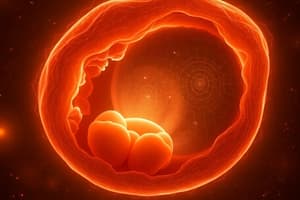Podcast
Questions and Answers
Which signaling proteins family is involved in a wide variety of processes, most noticeably in normal development?
Which signaling proteins family is involved in a wide variety of processes, most noticeably in normal development?
- Cyp26
- Retinoic acid
- Wnts
- FGF (correct)
What kind of factors are Wnts in the context of embryonic development?
What kind of factors are Wnts in the context of embryonic development?
- Suppressors of cell motility
- Activators of diverse signaling cascades (correct)
- Inhibitors of differentiation
- Stabilizers of anterior gene expression
Which enzyme regulates the coordinated regulation of the anterior-posterior axis in zebrafish, specifically in the neural ectoderm patterning?
Which enzyme regulates the coordinated regulation of the anterior-posterior axis in zebrafish, specifically in the neural ectoderm patterning?
- Cyp26
- RA receptor
- FGF
- Retinoic acid 4-hydroxylase (correct)
What is retinoic acid's role as a morphogen in cell regulation?
What is retinoic acid's role as a morphogen in cell regulation?
Where is the gene encoding the enzyme cyp26, which is pivotal in zebrafish's neural ectoderm patterning, expressed?
Where is the gene encoding the enzyme cyp26, which is pivotal in zebrafish's neural ectoderm patterning, expressed?
Which factor plays a key role in regulating cell properties dependent on its concentration during embryonic development?
Which factor plays a key role in regulating cell properties dependent on its concentration during embryonic development?
What is the role of retinoic acid-4-hydroxylase in hindbrain development?
What is the role of retinoic acid-4-hydroxylase in hindbrain development?
How do FGFs and Wnts reciprocate the inhibition by retinoic acid-4-hydroxylase?
How do FGFs and Wnts reciprocate the inhibition by retinoic acid-4-hydroxylase?
What role do NODAL signaling and Pitx2 transcription factor play in zebrafish left-right axis development?
What role do NODAL signaling and Pitx2 transcription factor play in zebrafish left-right axis development?
How is the left-right asymmetry controlled in zebrafish embryos?
How is the left-right asymmetry controlled in zebrafish embryos?
What happens when ciliary function is blocked in zebrafish embryos?
What happens when ciliary function is blocked in zebrafish embryos?
How does reciprocal inhibition create a border between posterior and anterior gene expression zones?
How does reciprocal inhibition create a border between posterior and anterior gene expression zones?
What is responsible for imparting dorsal-ventral patterning to the developing neural tube in the text?
What is responsible for imparting dorsal-ventral patterning to the developing neural tube in the text?
Which major phase in AP patterning involves the formation of muscles tissue blocks called somites in the vertebrate embryo?
Which major phase in AP patterning involves the formation of muscles tissue blocks called somites in the vertebrate embryo?
Where is the part of a very important signaling center called the organizer first specified in zebrafish?
Where is the part of a very important signaling center called the organizer first specified in zebrafish?
During which phase does the initiation phase occur in zebrafish in relation to gastrulation?
During which phase does the initiation phase occur in zebrafish in relation to gastrulation?
Which molecule is NOT mentioned as being involved in AP patterning in the text?
Which molecule is NOT mentioned as being involved in AP patterning in the text?
Which process involves cells migrating towards the animal pole where the brain forms?
Which process involves cells migrating towards the animal pole where the brain forms?
Flashcards
Gastrulation and AP Axis Formation
Gastrulation and AP Axis Formation
The most posterior cells of the embryo move towards the vegetal pole, forming the tailbud, and the animal-vegetal pole establishes the AP axis.
Patterning of Neural Ectoderm
Patterning of Neural Ectoderm
The regulation of neural ectoderm patterning along the AP axis in zebrafish involves the interplay of different signaling molecules.
Retinoic Acid as a Morphogen
Retinoic Acid as a Morphogen
Retinoic acid (RA) acts as a morphogen, influencing cell properties based on its concentration.
Retinoic Acid-4-Hydroxylase (cyp26)
Retinoic Acid-4-Hydroxylase (cyp26)
Signup and view all the flashcards
Shh's Role in Dorsal-Ventral Patterning
Shh's Role in Dorsal-Ventral Patterning
Signup and view all the flashcards
Evolutionary Significance of AP Axis
Evolutionary Significance of AP Axis
Signup and view all the flashcards
AP Axis in Bilaterians
AP Axis in Bilaterians
Signup and view all the flashcards
Mechanisms of AP Axis Formation
Mechanisms of AP Axis Formation
Signup and view all the flashcards
Phases of AP Patterning
Phases of AP Patterning
Signup and view all the flashcards
Initiation Phase in Zebrafish
Initiation Phase in Zebrafish
Signup and view all the flashcards
Left-Right Axis Formation
Left-Right Axis Formation
Signup and view all the flashcards
Left-Right Asymmetry in Vertebrates
Left-Right Asymmetry in Vertebrates
Signup and view all the flashcards
NODAL and Pitx2 in Asymmetry
NODAL and Pitx2 in Asymmetry
Signup and view all the flashcards
Study Notes
Gastrulation and AP Axis Formation
- The most posterior cells migrate towards the vegetal pole, forming the tailbud, and the AP axis aligns with the animal-vegetal pole by the end of gastrulation.
- The patterning of neural ectoderm along the AP axis in zebrafish involves the interplay of FGF, Wnts, and retinoic acid.
Regulation of AP Axis
- Retinoic acid (RA) acts as a morphogen, regulating cell properties depending on its concentration:
- Cells receiving low RA express anterior genes
- Cells receiving high RA express posterior genes
- Cells receiving intermediate RA express genes characteristic of cells between anterior and posterior regions
- Retinoic acid-4-hydroxylase (cyp26) degrades RA and is expressed at the anterior end of the embryo, preventing accumulation of RA and blocking posterior gene expression.
Dorsal-Ventral Patterning
- Shh secreted from the notochord imparts dorsal-ventral patterning to the developing neural tube.
Anterior-Posterior Axis
- The AP axis is the first embryonic axis to arise in evolution, allowing animals to move unidirectionally.
- In modern bilaterians, the AP axis corresponds to the head-tail axis.
- Different animals use various mechanisms to create this axis in the early embryo.
AP Axis Formation in Zebrafish
- AP patterning in the vertebrate embryo can be divided into two phases:
- Initiation phase: embryo divided into head and body
- Elaboration phase: body forms towards the posterior end, forming the trunk and tail
- In zebrafish, the initiation phase occurs prior to gastrulation, and the different territories of the final body plan can be roughly mapped onto the embryo.
Left-Right Axis Formation
- The series of embryonic development that distinguish the left and right sides of the embryo include:
- Direction of axial rotation
- Morphogenesis of individual organs
- Organ placement
- In vertebrates, the left and right sides develop differently, with the heart on the left side in fish.
- NODAL signaling and the Pitx2 transcription factor provide left-right asymmetry information to cells on the left side of the body.
Studying That Suits You
Use AI to generate personalized quizzes and flashcards to suit your learning preferences.




